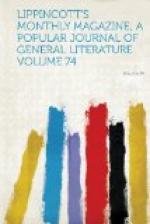A more solid memento of the Saxons is preserved in the King’s Stone. This has been of late years set up in the centre of the town, surrounded with an iron railing, and made visible to all comers, skeptical or otherwise. Tradition credits it with having been that upon which the kings of Wessex were crowned, as those of Scotland down to Longshanks, and after him the English, were on the red sandstone palladium of Scone. From the list of ante-Norman monarchs said to have received the sceptre upon it the poetically inclined visitor will select for chief interest Edwy, whose coronation was celebrated in great state in his seventeenth year. How he fell in love with and married secretly his cousin Elgiva; how Saint Dunstan and his equally saintly though not regularly beatified ally, Odo, archbishop of Canterbury, indignant at a step taken against their fulminations and protests, and jealous of the fair queen, tore her from his arms, burnt with hot iron the bloom out of her cheeks, and finally put her to death with the most cruel tortures; and how her broken-hearted boy-lord, dethroned and hunted, died before reaching twenty,—is a standing dish of the pathetic. Unfortunately, the story, handed down to us with much detail, appears to be true. We must not accept it, however, as an average illustration of life in that age of England. The five hundred years before the Conquest do not equal, in the bloody character of their annals, the like period succeeding it. Barbarous enough the Anglo-Saxons were, but wanton cruelty does not seem to have been one of their traits. To produce it some access of religious fury was usually requisite. It was on the church doors that the skins of their Danish invaders were nailed.
[Illustration: WALTON CHURCH.]
[Illustration: KINGSTON CHURCH.]
Kingston has no more Dunstans. Alexandra would be perfectly safe in its market-place. The rosy maidens who pervade its streets need not envy her cheeks, and the saints and archbishops who are to officiate at her husband’s induction as head of the Anglican Church have their anxieties at present directed to wholly different quarters. They have foes within and foes without, but none in the palace.
Kingston bids fair to revert, after a sort, to the metropolitan position it boasted once, but has lost for nine centuries. The capital is coming to it, and will cover the four remaining miles within a decade or two at the existing rate of progress. Kingston may be assigned to the suburbs already. It is much nearer London, in point of time, than Union Square in New York to the City Hall. A slip of country not yet endowed with trottoirs and gas-lamps intervenes. Call this park, as you do the square miles of such territory already deep within the metropolis.




